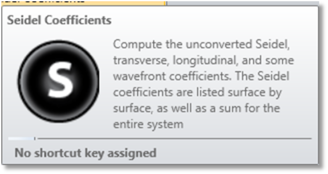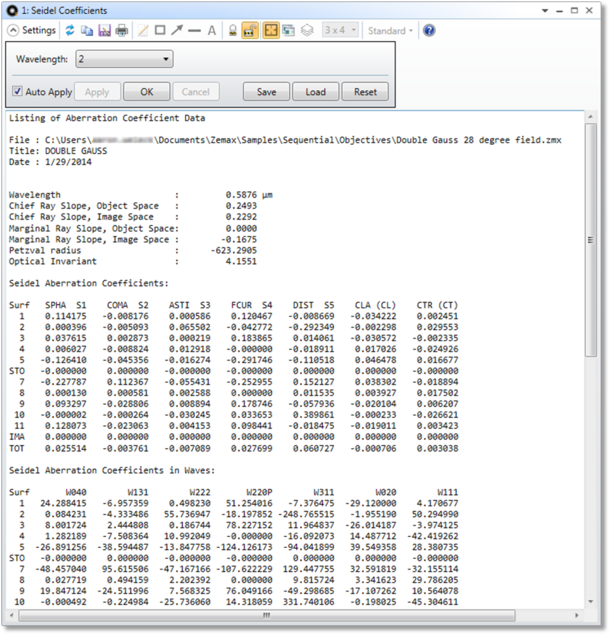Seidel Coefficients


Displays Seidel (unconverted, transverse, and longitudinal), and wavefront aberration coefficients.

Wavelength The wavelength number to use for the calculation.
Discussion
OpticStudio will compute the unconverted Seidel, transverse, longitudinal, and some wavefront coefficients. The Seidel coefficients are listed surface by surface, as well as a sum for the entire system. The coefficients listed are for spherical aberration (SPHA, S1), coma (COMA, S2), astigmatism (ASTI, S3), field curvature (FCUR, S4), distortion (DIST, S5), longitudinal color (CLA, CL), and transverse color (CTR, CT). The units are always the same as the system lens units, except of course for the coefficients measured in waves.
These calculations are only valid and accurate for systems consisting entirely of surfaces that are axial symmetric spheres, conic, second order, or fourth order aspheres. Any systems which contain coordinate breaks, gratings, paraxial, or other surfaces that are not radially symmetric are not adequately described by the paraxial rays which are used to compute the coefficients. Specifically, the supported surface types are the Standard, Even Asphere, Odd Asphere, Extended Asphere, and Extended Odd Asphere.
Transverse aberration coefficients are listed for each surface and for the system as a whole. The coefficients given are transverse spherical (TSPH), transverse sagittal coma (TSCO), transverse tangential coma (TTCO), transverse astigmatism (TAST), transverse Petzval field curvature (TPFC), transverse sagittal field curvature (TSFC), transverse tangential field curvature (TTFC), transverse distortion (TDIS), transverse axial color (TAXC), and transverse lateral color (TLAC). The transverse aberrations are in the system lens units. The transverse aberration coefficients may be very large in optical spaces where the light is nearly collimated, and have little meaning in these optical spaces.
The Petzval Radius, which is the inverse of the Petzval Sum, is:
where ni-1 and ni are refractive indexes before and after the surface number i. The Ri is the radius of curvature of the surface number i. The nm is the index of image surface. The m is the surface number of image surface.
The Petzval Radius will take into account the absolute value of the refractive index in both Object Space and Image Space. The Object and Image Radius are ignored for this calculation.
Longitudinal aberration coefficients are computed for longitudinal spherical aberration (LSPH), longitudinal sagittal coma (LSCO), longitudinal tangential coma (LTCO), longitudinal astigmatism (LAST), longitudinal Petzval field curvature (LPFC), longitudinal sagittal field curvature (LSFC), longitudinal tangential field curvature (LTFC), longitudinal distortion (LDIS), longitudinal axial color (LAXC), and longitudinal lateral color (LLAC). The longitudinal aberrations are in the system lens units. The longitudinal aberration coefficients may be very large in optical spaces where the light is nearly collimated, and have little meaning in these optical spaces.
The wavefront coefficients given are spherical aberration (W040), coma (W131), astigmatism (W222), field curvature Petzval (W220P), distortion (W311), axial color defocus term (W020), lateral color tilt term (W111), field curvature sagittal (W220S), field curvature medial (W220M), and field curvature tangential (W220T). All the wavefront coefficients are in units of wavelengths at the edge of the exit pupil. The various aberration coefficients are interrelated according to the following table. The n' and u' values are the index of refraction and the paraxial marginal ray angle at the last surface in the system. For a discussion of the meaning and derivation of the Seidel aberration coefficients, see Welford, Aberrations of Optical Systems, Smith, Modern Lens Design, or O' Shea, Elements of Modern Optical Design. A list of good references can be found in "References on Lens Design".
| Name | Seidel | Wave | Description | Transverse | Longitudinal |
|
Spherical |
|
|
Spherical |
|
|
|
Coma |
|
|
Sagittal |
|
|
| Tangential |
|
|
|||
| Astigmatism |
|
|
From tangential to sagittal foci |
|
|
|
Field Curvature |
|
|
Gaussian to Petzval |
|
|
|
|
|
Gaussian to sagittal |
|
|
|
|
|
|
Gaussian to medial |
|
|
|
|
|
|
Gaussian to tangential |
|
|
|
|
Distortion |
|
|
Distortion |
|
|
| Axial Color |
|
|
Chromatic aberrations are measured between the extreme defined wavelength, referenced to the selected wavelength. |
|
|
| Lateral Color |
|
|
|
|
The Seidel coefficients are easily related to the wavefront aberrations:
S1 = 8 W040
S2 = 2 W131
S3 = 2 W222
S4 = 4 W220 - 2 W222
S5 = 2 W311
Next:


